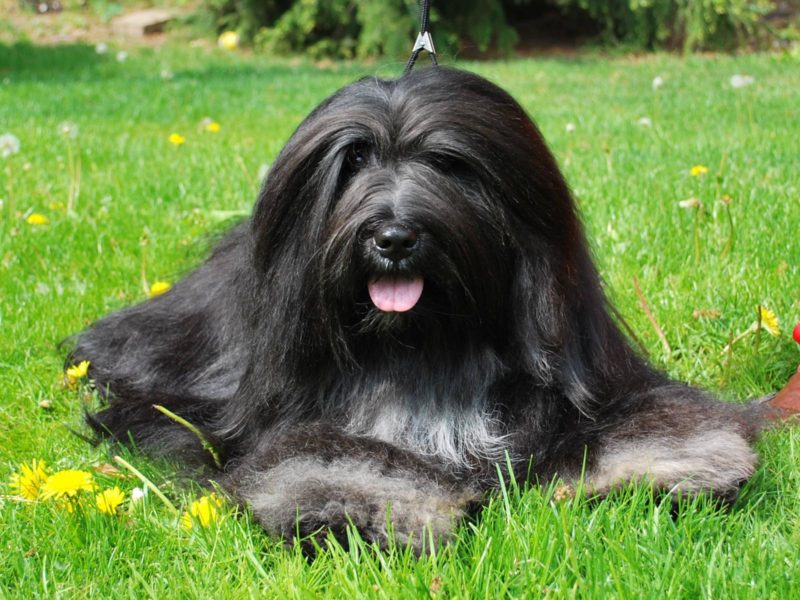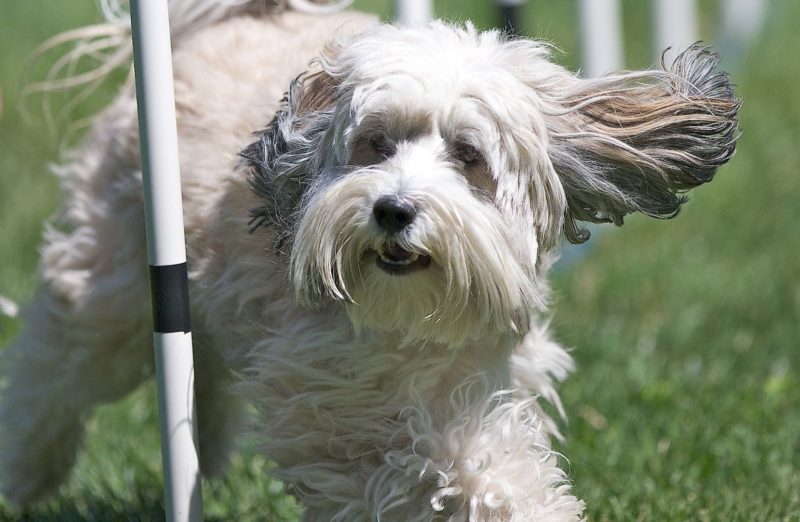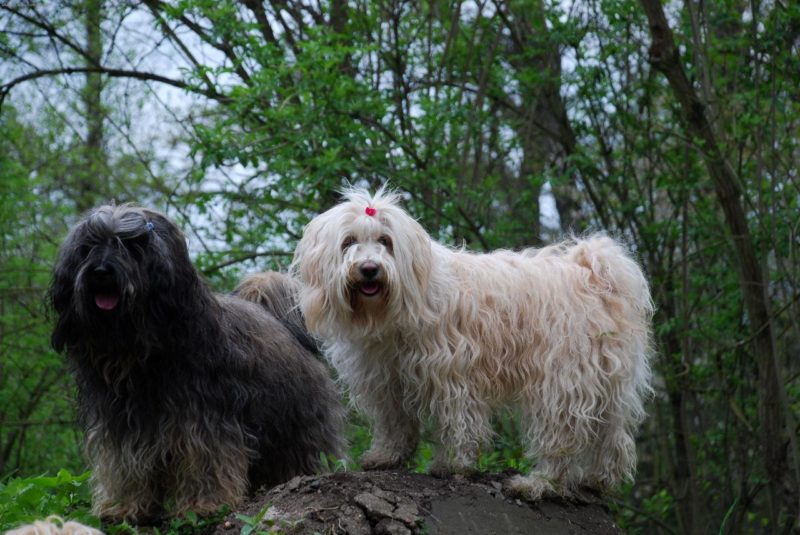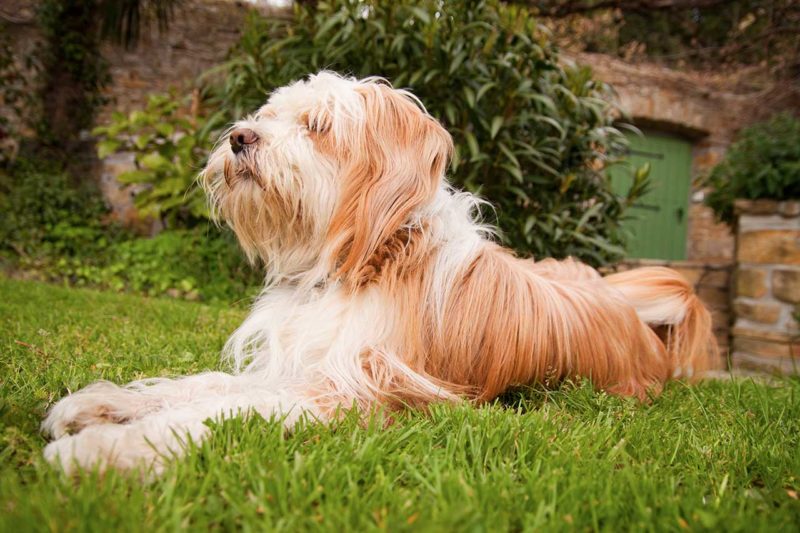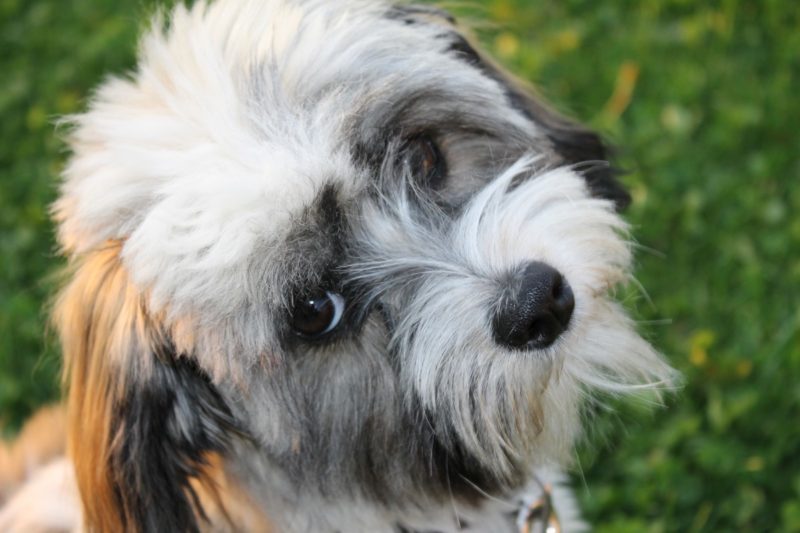This breed is for those people who value in dogs boundless devotion, courage, intellect and balanced temperament. The Tibetan Terrier in his homeland was considered the talisman of luck, a sacred animal that can protect the owner from evil spirits.
Material Content:
Description of the breed and its varieties
Thanks to its small size, beautiful long coat and active temperament, the Tibetan Terrier can become an excellent companion and pet. An adult dog resembles an Old English Shepherd in appearance.
Using genetic analysis, scientists have established that this oldest breed has nothing to do with terriers. It got its name thanks to the Europeans who traveled to Tibet. In the historical homeland of dogs they call Tsang Apso, which in translation sounds like “a shaggy dog from Tsang province”.
The long hair of terriers consists of a thick long undercoat and outer hair. Without a haircut, the coat almost reaches the ground, the fringe on the head closes the eyes and muzzle, leaving only the nose lobe visible. Color is allowed any, except chocolate, dogs with wool of the color of ripe wheat are very appreciated.
Origin history
The Tibetan Terrier is an ancient and rare breed. It appeared in Tibet many hundreds of years ago, due to the inaccessibility of the region and its isolation from the outside world, it retained its purebredness.
Larger representatives of the breed guarded herds on mountain pastures, were excellent helpers of shepherds.Small Tibetan terriers lived at the monasteries and were revered by the monks as sacred animals. According to ancient legends, dogs protected their owners from evil spirits and brought good luck. Outside the country, animals were not sold.
The first owner of the Tibetan Terrier in Europe was the Englishwoman Agnes Greig. She worked in a hospital in a small Indian city on the border with Tibet. A seriously ill Tibetan woman came for treatment with her dog, which was soon to give birth to puppies. Agnes took the animal for a while. When the mistress recovered, she gave the Englishwoman a puppy in gratitude. He grew up, they found a couple, and the first litter of Tibetan terriers appeared in England. In 1937, the breed received official recognition in the Constitutional Court.
The nature and behavior of the Tibetan Terrier
The nature of the breed has been shaped for centuries. For grazing and protecting sheep from predators, she needed endurance and physical strength, courage and devotion to the owner. High intellect helped to cope with the duties of a shepherd.
Modern Tibetan terriers have preserved protective qualities, stamina, activity, quick wit, courage. They are faithful, good-natured and calm. To feel good, they need constant physical activity. In Europe, this rare breed is not used for official purposes, but kept as companion dogs.
Breed standard and puppy selection
A strong dog of small or medium size with long hair, a good-natured face, covered with long bangs - this is how the Tibetan terrier looks.
Description of the breed and requirements of the standard:
- medium sized head;
- rounded skull;
- ears hanging;
- large dark eyes are located far from each other;
- the muscular neck proudly carries its head above the level of the back;
- tail of medium length, bent up;
- the body is strong, muscular and compact;
- paws are large, rounded, with hair between fingers;
- gait is smooth;
- height at the withers from 32 to 41 cm, weight from 8 to 13 kg.
The coat can be straight or slightly wavy, without curls. It grows for a long time and rarely sheds. Puppies have short or medium hair.
If you really want to get a Tibetan terrier, you need to take a closer look at the breed, visit several exhibitions, see various breeding lines. You can take the contact phone number from the owner of the animal you like and find out when the next mating is planned. Having learned about the appearance of the desired litter, it is better to come to the kennel yourself, see the conditions in which the dogs are kept. If you liked everything, the last important step remains - to choose a single puppy who will become a friend and a member of the family. The breeder must give the puppy card and the medical booklet with vaccination marks upon purchase.
Features of keeping a dog
The Tibetan Terrier has a friendly and affectionate temperament, he is very balanced and quick-witted. Suitable for maintenance in a city apartment, requires daily walks and physical activity.
You can engage in various sports with your pet, run in the mornings or just walk for a long time, diversifying your leisure with outdoor games. Active movement and activities with the owner are important for canine health and intellectual development. With a lack of attention and walking, a depressed state, depression, irritability, and poor appetite are possible.
Paws and breasts are washed after each walk. The haircut of the Tibetan terrier should not be short; the outer hair will grow for a long time. Shaggy wool almost does not shed, but requires careful care. If the dog does not participate in exhibitions, you can do a haircut yourself.
Care, health and nutrition
At first glance at the Tibetan terrier, it immediately becomes clear that its coat requires special care. It is recommended to comb out at least 1 time per week, and even better daily.First, with a simple comb, comb the thick undercoat well, unraveling all the tangles, then make the final styling with a brush. The teeth of the brush should be without “droplets” at the end, so as not to injure the coat.
They bathe the dog 1 time in 10 days using special mild shampoos and conditioners appropriate for the color. After bathing, wipe your ears. Once a month, claws are cut. They monitor the health of the teeth, when plaque is formed, clean it with activated charcoal or special paste for animals. With the formation of tartar, you will need the help of a veterinarian.
Among Tibetan terriers there are 20-year-old centenarians, but the average life expectancy of most representatives of the breed is 12 years. Dogs have strong immunity and a very sensitive nervous system. They are sensitive to the mood and behavior of the owner.
Of congenital diseases that are inherited, the most common pathologies of the eyes and joints are:
- dislocation of the patella;
- hip dysplasia;
- cataract;
- damage to the lens;
- atrophy, heart murmur.
Sick animals are not allowed for breeding, therefore it is better to acquire a puppy with documents in the nursery.
To maintain the health of the Tibetan Terrier, it is important not only the good attitude of the owner, but also good nutrition. On sale you can find a lot of dry finished feed of good quality. Experienced dog breeders advise when choosing such products to pay attention not to the price and brand name, but to the composition prescribed by the manufacturer on the package. It should indicate natural meat, not meat and bone meal plus cereals, preservatives and flavor enhancers.
There are special feeds that are beneficial for the health of the coat. It is impossible to achieve a beautiful appearance with one bath and combing; a decorative dog should receive the necessary vitamins and minerals with food. Those who feed the pet with natural products know that it is necessary to give from time to time the vitamin and mineral complexes prescribed by the veterinarian.
Not every owner can make a high-quality natural diet. Leftovers from half-eaten foods on the general table will not work.
How to organize nutrition with natural products:
- Buy lean meat - beef, chicken, rabbit meat, lamb.
- Freeze in the freezer for three days.
- Then get the necessary portion when thawed, cut and give to the dog. Such low-temperature processing destroys parasites and preserves all the beneficial properties of meat.
- The dog should receive from 10 to 20 g of protein per 1 kg of body weight. So, with a weight of 10 kg, she needs to give from 0.5 to 1 kg of beef per day.
- In addition to meat, a small amount of vegetables, porridge from various cereals, cottage cheese, kefir, greens, boiled liver, quail eggs, boneless fish are added to the diet of a tailed friend.
Pure drinking water should always be freely available, and it is advisable to give food at certain times - in the morning and in the evening. Puppies of the Tibetan Terrier eat more often: from 3 to 6 months 4 times, after 6 months 3 times a day.
Parenting and training
Parenting starts from the first days when the puppy just gets into the apartment. He is taught obedience and good manners. Representatives of the breed are distinguished by high intelligence and a sensitive nervous system. They cannot stand screaming and rough treatment. Like all dogs, they want to see a leader in their master who can be fully trusted and obey without question.
In upbringing, consistency and respect for the pet is important. You cannot forbid or allow something, guided by your mood or momentary whim. The scope of the permitted should be consistent and understandable to the pet.
At the exhibition, the dog should be able to go through the ring, showing himself in all its glory. With animals master the course of OKD at the training site. If you have experience training, you can do it yourself.
Pros and cons of the breed
Tibetan Terriers are a beautiful and good-natured shepherd breed of dogs, infinitely devoted to their owner and his family. Tibetans can be good house guards, casting a voice if strangers approach. Get along well with children and pets. According to legend, bring good luck to their owners.
Only a lazy dog breeder who finds it difficult to care for the dog’s long hair and walk it daily can find the disadvantages of this breed.


